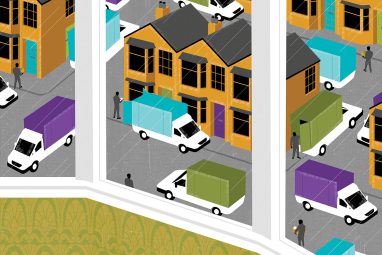How E-Commerce Companies Can Reduce Returns
Research shows that product returns decrease when online shoppers receive orders in a single, consolidated delivery.
News
- CERN and Pure Storage Partner to Power Data Innovation in High-Energy Physics
- CyberArk Launches New Machine Identity Security Platform to Protect Cloud Workloads
- Why Cloud Security Is Breaking — And How Leaders Can Fix It
- IBM z17 Mainframe to Power AI Adoption at Scale
- Global GenAI Spending to Hit $644 Billion by 2025, Gartner Projects
- e& enterprise Partners with MIT Sloan Management Review Middle East for GovTech Conclave 2025

Jon Krause/theispot.com
Retail executives love the lack of friction in online shopping that makes it fast and easy for customers to complete a purchase, and promising free returns is part of that. But the costs of those returns add up: Of the approximately $1.29 trillion in U.S. online retail sales in 2022, it’s estimated that $212 billion worth of goods — 16.4% of sales — were sent back. While that represents a reprieve for retailers from 2021, when the rate shot up to 20%, returns are up still significantly, from just 10.6% in 2020. It’s putting e-commerce executives under pressure to lower these unsustainable numbers.
The managers we work with on fulfillment strategies keep coming back to two less-obvious, intertwined questions regarding product returns: Does the current common strategy of putting the lion’s share of resources toward speedy delivery affect the return rate? And could a fulfillment approach that deprioritizes speed and instead aims to consolidate multiple-item orders into single, large deliveries improve return rates?
The issue matters not only to those invested in lowering reverse-logistics costs but also to colleagues in sales and marketing, since sales figures can oscillate dramatically as return rates and refunds are factored in.
Research we’ve conducted to answer these questions could challenge the assumptions underlying online delivery practices that, often counterintuitively, lead to higher rates of returns. We found that delivering all products in an order together, even if that means later delivery for some items, lowers the probability of returns. Our results suggest that delivery speed matters less to customers than the convenience of receiving all ordered items in a single delivery.
In this article, we’ll look more closely at our findings and at what might drive customers to keep more purchases when deliveries are consolidated. We’ll also offer suggestions for adapting fulfillment strategies to these findings.
Better Together
In a typical e-commerce scenario, the seller seeks to expedite items in an order. It might ship items from different stock locations; for example, a dress from last season might ship from an offline store that still has one on its clearance rack, while other items might come from the seller’s main distribution center. A customer might receive the items shipped from the distribution center within 48 hours but will have to wait one more day for the dress to arrive in a separate package.
Today’s online retailers have a tremendous amount of data that can yield important insights about customer delivery preferences. To assess how online customers value trade-offs between speed and consolidation, we analyzed the behavior of online customers of a fashion marketplace across hundreds of thousands of purchasing instances. In each case, we investigated what the customer ordered, whether delivery was consolidated or split, and whether items were returned.
Analyzing customers’ return rates for the marketplace, we found that the company would benefit significantly if the items were delivered in consolidated shipments instead of split — even if some things were to arrive later. The estimates for our case study show that consolidating all split orders would have decreased the marketplace’s return rate by about 1 percentage point.
Today’s online retailers have a tremendous amount of data that can yield important insights about customer delivery preferences.
Moreover, when more customers retained their goods, thereby lowering reverse logistics costs, we saw improvements in the order net value, of 1.23 percentage points, for the marketplace we partnered with. Ultimately, this translated into an increase in the contribution margin per order of 0.29 points.
While these findings emerged from shoppers focused on fashion, they are likely applicable to other online retailers from which customers typically buy multiple items at once, such as sellers of furniture, home goods, appliances, and other durable goods. Moreover, our approach of using past fulfillment data to understand customers’ online delivery preferences is relevant to any retailer on the verge of rethinking its fulfillment strategy.
Need for Closure
Our findings are counterintuitive for most retail managers, who typically prioritize speedy delivery based on the assumption that what customers want most is fast gratification. But there is a psychological phenomenon that might explain why split deliveries can prompt more returns: the sense of incompleteness that a disaggregated order might cause. Just after placing an online order, a customer may well receive two separate emails acknowledging that the order was received (one for each package) and then another two when each one is dispatched. This could trigger the Zeigarnik effect, named after psychologist Bluma Zeigarnik, who observed that our brains constantly remind us of unfinished tasks, whereas completed tasks are largely forgotten.
This need for closure creates a mental tension that is expressed as a desire to finish the interrupted task that gives it memorial prominence. So a customer who has received only one of their order’s two parcels might not feel that their purchasing task has been completed until all of their items have been delivered. This mental burden may translate into lower satisfaction and higher returns.
We think that this need for task completion is likely the driving force behind customers being more satisfied when purchases arrive in consolidated deliveries. In other words, consolidation reduces the mental stress on consumers, lowering product returns and boosting profits. Retailers can think creatively about strategies to reduce this tension, even if they have to split deliveries. For example, they can increase communication after the first delivery to assure customers that everything is under control.
Orchestrating the Supply Chain
How can retailers start orchestrating their supply chains differently to ensure that delivery consolidation happens more often? The most straightforward suggestion is to enforce consolidation across the board. That would likely result in lower return rates and higher profitability.
However, such an approach requires that the retailer work with a fairly small portfolio of delivery companies to ensure that consolidation can happen without transferring stock between them — and that limits the price negotiation power that a larger portfolio of courier relationships can provide. That may be balanced out by unlocking additional savings in forward shipping costs, since each order, regardless of the parcels it produced, would result in just one customer delivery.
The truth is that some customers will prefer speed over convenience. Therefore, a more nuanced approach is to let customers have a say in the consolidation decisions affecting their orders. Hence, when customers place an online order, they should be given an option at checkout as to whether they want their items delivered together even if it might mean a longer delivery time. There is no doubt that some people will say no — they’ll want their items fast. But we believe that many more people will opt for a single delivery.
Other retailers may prefer to intervene in the supply chain dynamically and in real time to consolidate the delivery of each customer order in certain circumstances. For the marketplace we teamed with, this would mean consolidating all orders with either a long delivery spread (the time between the delivery of two items of the same order) or a longer delivery lead time.
This strategy would require the marketplace to track the parcels produced by each order and estimate their time of arrival at the consolidation point, where the order could be combined into a single shipment. Based on these estimates, the retailer would decide whether the delivery should be split or consolidated.
Indeed, any fulfillment strategies that increase the likelihood of consolidated orders should decrease the probability of returns. And when retailers stop racing to deliver individual items as fast as possible, they might gain efficiency — and, more important, improve their environmental impact.





